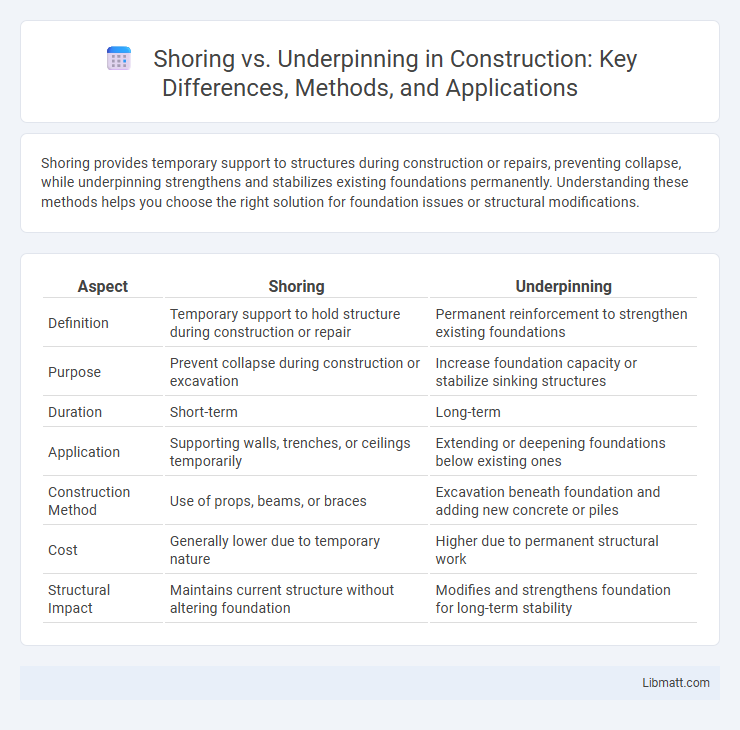Shoring provides temporary support to structures during construction or repairs, preventing collapse, while underpinning strengthens and stabilizes existing foundations permanently. Understanding these methods helps you choose the right solution for foundation issues or structural modifications.
Table of Comparison
| Aspect | Shoring | Underpinning |
|---|---|---|
| Definition | Temporary support to hold structure during construction or repair | Permanent reinforcement to strengthen existing foundations |
| Purpose | Prevent collapse during construction or excavation | Increase foundation capacity or stabilize sinking structures |
| Duration | Short-term | Long-term |
| Application | Supporting walls, trenches, or ceilings temporarily | Extending or deepening foundations below existing ones |
| Construction Method | Use of props, beams, or braces | Excavation beneath foundation and adding new concrete or piles |
| Cost | Generally lower due to temporary nature | Higher due to permanent structural work |
| Structural Impact | Maintains current structure without altering foundation | Modifies and strengthens foundation for long-term stability |
Introduction to Shoring and Underpinning
Shoring involves temporary support structures to stabilize a building or trench during construction or repairs, preventing collapse and ensuring safety. Underpinning strengthens and stabilizes the foundation of an existing structure by extending it deeper or wider, often used to address foundation settlement or increase load capacity. Understanding the differences between shoring and underpinning helps you choose the appropriate method for structural integrity and project requirements.
Defining Shoring: Purpose and Applications
Shoring involves temporary support structures used to stabilize and secure buildings, trenches, or excavations during construction or repairs to prevent collapse. Common applications include supporting weak walls, trenches, or excavations in construction sites, ensuring worker safety and structural integrity. It is a critical technique in maintaining stability until permanent structural reinforcements are installed.
Understanding Underpinning: Key Concepts
Underpinning involves strengthening an existing foundation to enhance stability and support, often necessary when the original foundation is insufficient or damaged. It requires carefully excavating beneath the structure and adding new concrete or other materials to extend the foundation's depth or breadth, ensuring long-term durability. Understanding these key concepts helps you determine when underpinning is the appropriate solution compared to shoring, which provides temporary support during construction.
Differences Between Shoring and Underpinning
Shoring involves temporary support structures to stabilize a building during construction or excavation, whereas underpinning permanently strengthens and deepens an existing foundation. Shoring is typically used when external forces or excavation threaten structural stability, while underpinning addresses foundation settlement or instability problems. Understanding these core differences helps you choose the right method for ensuring structural safety and longevity.
Common Types of Shoring Methods
Common types of shoring methods include vertical shoring, which supports structures by placing posts or braces directly under load-bearing points, and horizontal shoring, which stabilizes walls using beams or bracing to resist lateral pressure. Raking shoring involves angled supports to counteract forces from sloping surfaces, often used in trench or excavation work. These methods are essential for preventing building collapse during construction, excavation, or repair projects.
Popular Underpinning Techniques Explained
Popular underpinning techniques include mass concrete underpinning, beam and base underpinning, and mini-piled underpinning, each designed to stabilize foundations by increasing load-bearing capacity or transferring loads to deeper, stable soil layers. Mass concrete underpinning involves extending the existing foundation with concrete to support heavier structures or compensate for weak soils. Understanding these methods helps you choose the best solution for your building's structural integrity and long-term safety.
When to Use Shoring vs Underpinning
Shoring is used when temporary support is needed during construction or excavation to prevent soil collapse and stabilize structures, especially in trenching or when external loads threaten stability. Underpinning is necessary when existing foundations are no longer safe, requiring permanent reinforcement or deepening to support a building due to settlement, structural damage, or load changes. Choosing between shoring and underpinning depends on project duration, purpose of support, and condition of the current foundation system.
Advantages and Disadvantages of Shoring
Shoring provides temporary structural support during construction or excavation, preventing collapse and ensuring worker safety, with advantages including cost-effectiveness and flexibility in various soil conditions. However, shoring can be labor-intensive, requires constant monitoring for stability, and is not suitable for long-term support compared to underpinning. Its use is ideal for short-term projects but may pose risks if improperly designed or implemented in complex structural environments.
Benefits and Drawbacks of Underpinning
Underpinning strengthens building foundations by extending their depth or breadth, providing increased stability in cases of subsidence or structural weakness. It offers long-term durability and can adapt to varying soil conditions, yet the process often requires significant excavation, leading to higher costs and potential disruption to occupants. Despite its effectiveness in preventing further settlement, underpinning may also pose risks such as structural damage during installation if not properly managed.
Factors to Consider for Project Selection
When deciding between shoring and underpinning, key factors to consider include the soil conditions, the structural stability of the existing foundation, and the load-bearing requirements. Your project's timeline and budget constraints also influence the choice, as shoring typically provides temporary support during construction while underpinning offers a permanent foundation solution. Evaluating the surrounding environment and potential impacts on adjacent structures ensures the selected method aligns with safety and regulatory standards.
Shoring vs Underpinning Infographic

 libmatt.com
libmatt.com